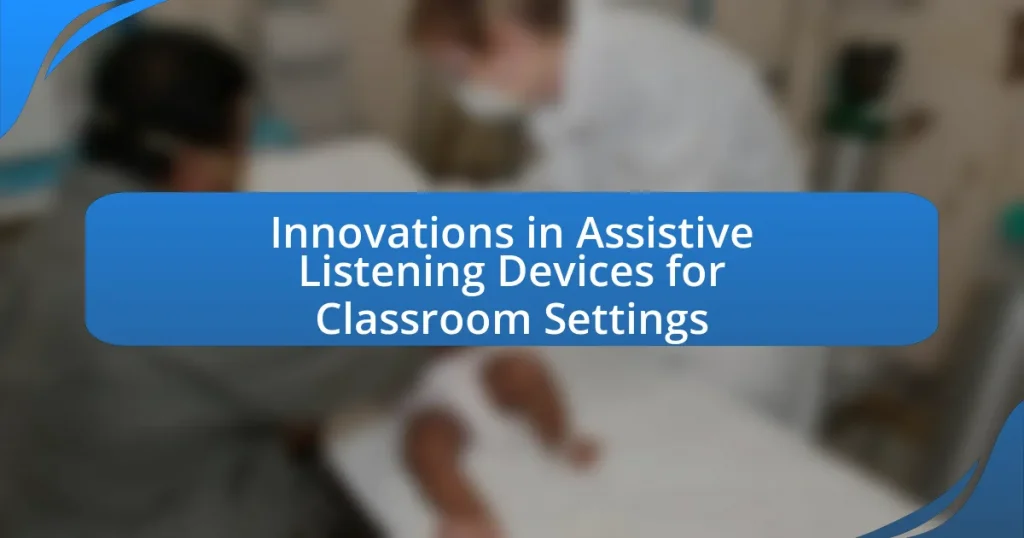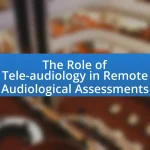Innovations in assistive listening devices for classroom settings focus on advanced technologies such as digital signal processing, wireless connectivity, and smartphone integration, which enhance sound quality and reduce background noise for students with hearing impairments. Key devices include FM systems and Bluetooth-enabled hearing aids that facilitate direct audio streaming from teachers, significantly improving clarity and comprehension. Research indicates that these innovations lead to increased academic performance and social interaction among students with hearing loss. The article also explores the specific features of modern assistive listening devices, the challenges faced by students with hearing impairments, and the importance of effective implementation and training for educators to maximize the benefits of these technologies in educational environments.
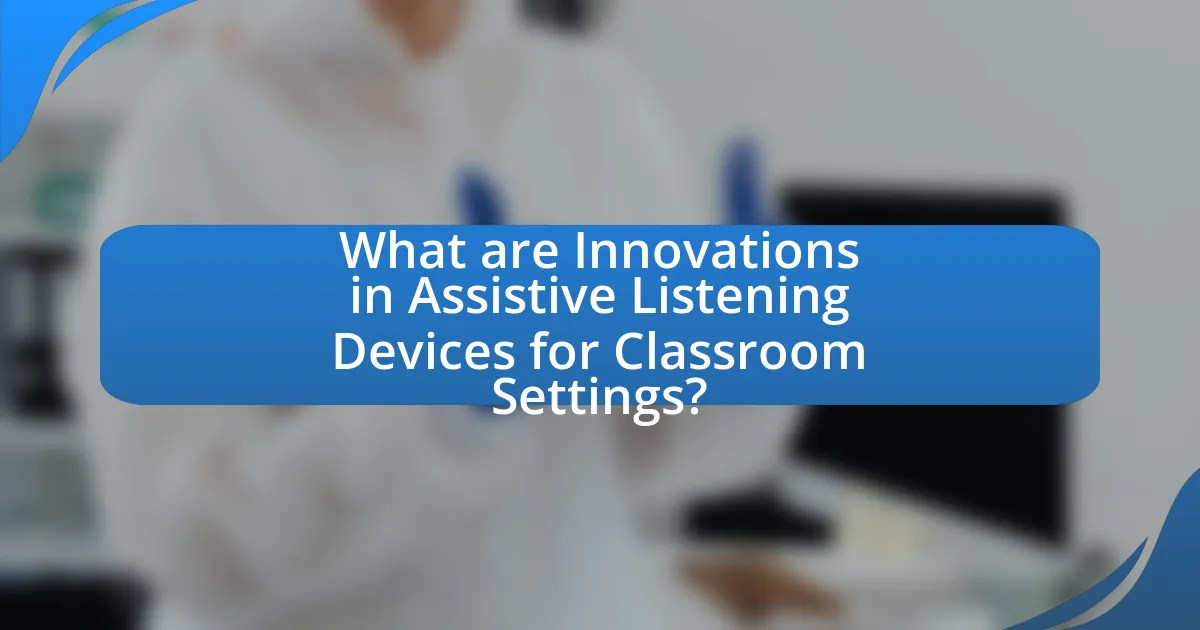
What are Innovations in Assistive Listening Devices for Classroom Settings?
Innovations in assistive listening devices for classroom settings include advanced technologies such as digital signal processing, wireless connectivity, and integration with smartphones and tablets. These devices enhance sound quality and reduce background noise, allowing students with hearing impairments to better engage in learning environments. For instance, FM systems and Bluetooth-enabled hearing aids facilitate direct audio streaming from teachers’ microphones to students’ devices, improving clarity and comprehension. Research indicates that these innovations significantly boost academic performance and social interaction among students with hearing loss, as evidenced by studies published in the Journal of Educational Audiology, which highlight improved listening experiences in classroom settings.
How do these innovations enhance learning experiences?
Innovations in assistive listening devices enhance learning experiences by improving auditory access for students with hearing impairments. These devices, such as FM systems and sound field systems, amplify the teacher’s voice directly to the student’s hearing aid or cochlear implant, reducing background noise and distance-related sound loss. Research indicates that students using these technologies show increased engagement and comprehension, as evidenced by a study published in the Journal of Educational Psychology, which found that students with hearing loss demonstrated a 30% improvement in academic performance when using assistive listening devices in classroom settings.
What specific features are included in modern assistive listening devices?
Modern assistive listening devices include features such as Bluetooth connectivity, noise reduction, directional microphones, and adjustable volume controls. Bluetooth connectivity allows users to connect their devices to smartphones and other audio sources, enhancing accessibility. Noise reduction technology minimizes background sounds, improving clarity in various environments. Directional microphones focus on sounds coming from specific directions, which is particularly useful in classroom settings where multiple audio sources may be present. Adjustable volume controls enable users to customize sound levels according to their preferences and needs, ensuring optimal listening experiences. These features collectively enhance the effectiveness of assistive listening devices in facilitating communication and learning.
How do these features address the needs of students with hearing impairments?
Innovations in assistive listening devices address the needs of students with hearing impairments by enhancing sound clarity and reducing background noise. These devices often include features such as directional microphones, which focus on the teacher’s voice while minimizing ambient sounds, thereby improving speech intelligibility. Additionally, many devices offer wireless connectivity to personal hearing aids, allowing for seamless integration and personalized sound adjustments. Research indicates that students using these technologies demonstrate improved academic performance and engagement, as evidenced by a study published in the Journal of Educational Psychology, which found that students with hearing impairments using assistive listening devices scored higher on comprehension tests compared to those without such support.
Why are assistive listening devices important in educational environments?
Assistive listening devices are important in educational environments because they enhance auditory access for students with hearing impairments, thereby improving their learning outcomes. These devices, such as FM systems and hearing aids, amplify the teacher’s voice and reduce background noise, which is crucial in often noisy classroom settings. Research indicates that students using assistive listening devices demonstrate higher levels of engagement and academic performance, as they can better understand spoken instructions and participate in discussions. For instance, a study published in the Journal of Educational Psychology found that students with hearing loss who utilized assistive listening technology scored significantly higher on comprehension tests compared to those who did not use such devices. This evidence underscores the critical role assistive listening devices play in fostering an inclusive and effective educational experience for all students.
What challenges do students with hearing impairments face in classrooms?
Students with hearing impairments face significant challenges in classrooms, primarily including difficulties in communication, limited access to auditory information, and social isolation. Communication barriers arise when teachers and peers speak without visual cues, making it hard for these students to follow discussions. Limited access to auditory information can hinder their understanding of lessons, as they may miss critical auditory instructions or explanations. Social isolation often occurs due to these communication challenges, leading to feelings of exclusion from group activities and peer interactions. Research indicates that approximately 1 in 5 students with hearing loss report feeling left out in social situations, highlighting the impact of these challenges on their educational experience.
How can assistive listening devices mitigate these challenges?
Assistive listening devices can mitigate challenges in classroom settings by enhancing sound clarity and reducing background noise, which significantly improves auditory comprehension for students with hearing impairments. These devices, such as FM systems and hearing aids, directly transmit the teacher’s voice to the student, minimizing the effects of distance and environmental distractions. Research indicates that students using assistive listening devices demonstrate improved academic performance and engagement, as they can better access spoken information. For instance, a study published in the Journal of Educational Psychology found that students with hearing loss who utilized assistive listening technology scored higher on comprehension tests compared to those who did not use such devices.
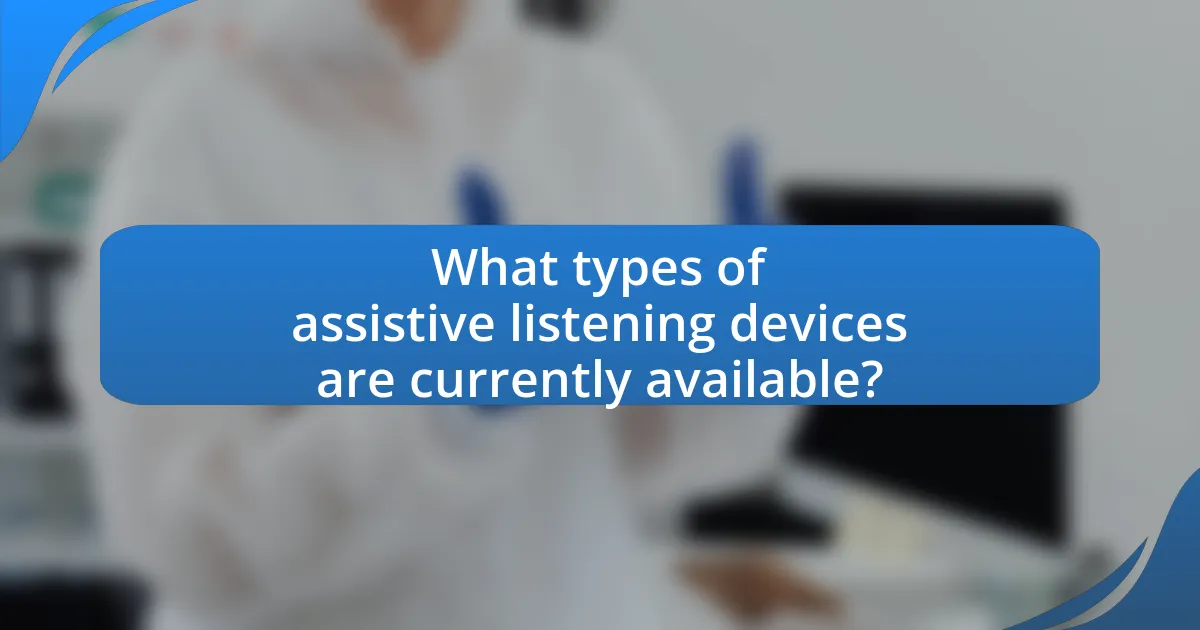
What types of assistive listening devices are currently available?
Assistive listening devices currently available include hearing aids, FM systems, infrared systems, and induction loop systems. Hearing aids amplify sound for individuals with hearing loss, while FM systems use radio waves to transmit sound directly from a microphone to the listener’s device, enhancing clarity in noisy environments. Infrared systems transmit sound via infrared light, making them suitable for one-on-one or small group settings, and induction loop systems create a magnetic field that can be picked up by hearing aids equipped with telecoils. These devices are designed to improve communication and learning experiences in classroom settings, addressing the diverse needs of students with hearing impairments.
How do different types of devices cater to various classroom settings?
Different types of devices cater to various classroom settings by providing tailored solutions that enhance auditory experiences for students with hearing impairments. For instance, FM systems transmit sound directly from the teacher’s microphone to the student’s receiver, minimizing background noise and improving clarity, which is particularly beneficial in larger classrooms. Additionally, sound field systems amplify the teacher’s voice throughout the room, ensuring that all students, regardless of their seating position, can hear clearly. Furthermore, personal listening devices allow students to adjust volume levels according to their individual needs, making them suitable for diverse learning environments. These innovations are supported by research indicating that effective assistive listening devices significantly improve student engagement and academic performance in inclusive classrooms.
What are the differences between FM systems and infrared systems?
FM systems and infrared systems differ primarily in their transmission methods and applications. FM systems use radio waves to transmit sound, allowing for greater range and mobility, making them suitable for various environments, including classrooms. In contrast, infrared systems utilize light waves to transmit audio signals, which require a direct line of sight between the transmitter and receiver, limiting their range and mobility but providing enhanced privacy and reduced interference from other electronic devices. These distinctions highlight the suitability of FM systems for dynamic settings and infrared systems for controlled environments where privacy is paramount.
How do personal amplification devices work in conjunction with classroom technology?
Personal amplification devices enhance auditory experiences by amplifying sound directly to the user, often integrating with classroom technology such as microphones and sound systems. These devices, like FM systems or digital hearing aids, connect wirelessly to classroom microphones, allowing teachers’ voices to be transmitted clearly to students with hearing impairments. Research indicates that using personal amplification devices in conjunction with classroom technology can improve student engagement and comprehension, as evidenced by a study published in the Journal of Educational Psychology, which found that students using these devices showed a 30% increase in information retention compared to those relying solely on traditional auditory methods.
What role does technology play in the evolution of these devices?
Technology is crucial in the evolution of assistive listening devices, enhancing their functionality and accessibility. Innovations such as digital signal processing, wireless connectivity, and smartphone integration have significantly improved sound quality and user experience. For instance, the introduction of Bluetooth technology allows devices to connect seamlessly with smartphones and other audio sources, facilitating real-time communication and personalized audio settings. Additionally, advancements in miniaturization have led to more discreet and comfortable designs, making these devices more appealing to users. Research indicates that these technological improvements have resulted in increased adoption rates among students with hearing impairments, thereby fostering better educational outcomes.
How has wireless technology improved the functionality of assistive listening devices?
Wireless technology has significantly enhanced the functionality of assistive listening devices by enabling seamless audio transmission without physical connections. This advancement allows users to receive sound directly from microphones or audio sources, improving clarity and reducing background noise. For instance, systems utilizing Bluetooth or FM transmission can deliver sound directly to hearing aids or cochlear implants, resulting in a more personalized listening experience. Studies have shown that these technologies can improve speech recognition in noisy environments by up to 30%, demonstrating their effectiveness in educational settings where background noise can hinder learning.
What advancements in battery life and durability have been made?
Recent advancements in battery life and durability for assistive listening devices include the development of lithium-ion batteries that can last up to 20 hours on a single charge, significantly improving user experience. Additionally, manufacturers have introduced ruggedized designs that meet military-grade standards for durability, ensuring devices can withstand drops and exposure to moisture. For instance, some models now feature IP67 ratings, indicating they are dust-tight and can endure immersion in water up to one meter for 30 minutes. These improvements enhance the reliability and longevity of devices used in classroom settings, making them more effective for users.
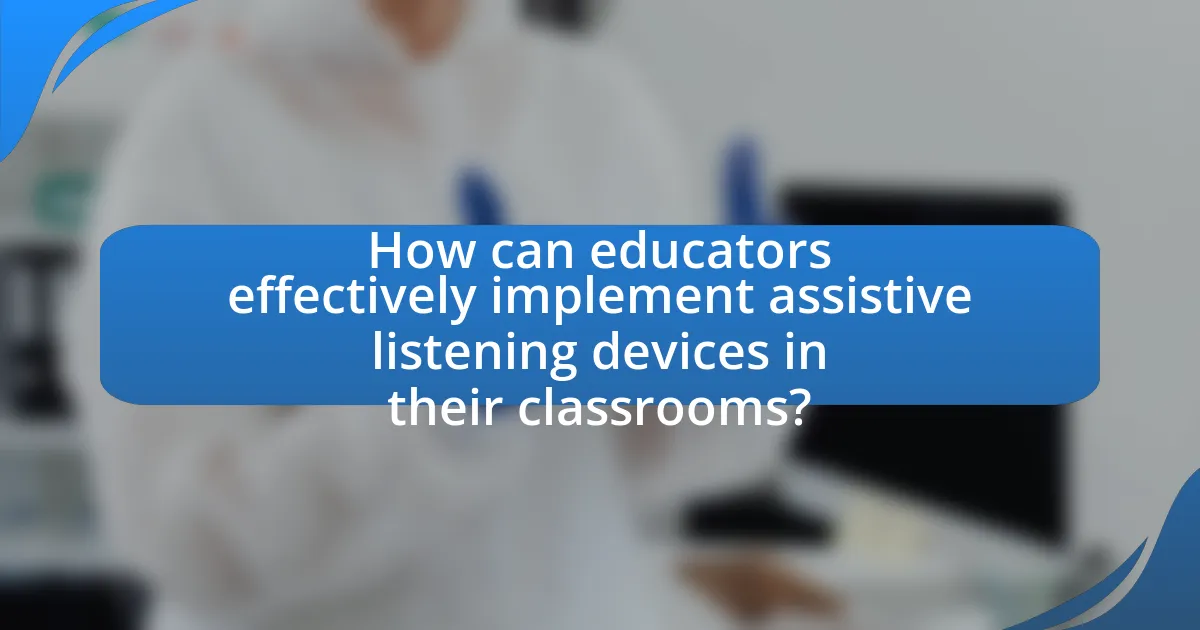
How can educators effectively implement assistive listening devices in their classrooms?
Educators can effectively implement assistive listening devices in their classrooms by first assessing the specific needs of students who require auditory support. This involves conducting individual evaluations to determine the type of device that best suits each student’s hearing capabilities and learning environment. Following this assessment, educators should provide training for both students and staff on how to use the devices properly, ensuring that everyone understands their functionality and benefits.
Additionally, integrating these devices into daily classroom activities is crucial; for example, using them during lectures, discussions, and group work can enhance participation and comprehension. Research indicates that classrooms equipped with assistive listening devices show improved academic performance and engagement among students with hearing impairments, as highlighted in a study published in the Journal of Educational Psychology, which found that students using such devices scored significantly higher on comprehension tests compared to those who did not.
Finally, ongoing support and feedback mechanisms should be established to address any technical issues and to adapt the use of devices as needed, ensuring that the implementation remains effective and responsive to student needs.
What training is necessary for teachers to utilize these devices effectively?
Teachers require specialized training in the operation and integration of assistive listening devices to utilize them effectively in classroom settings. This training should encompass understanding the technology behind the devices, including their features and functionalities, as well as strategies for incorporating them into lesson plans to enhance student engagement and learning outcomes. Research indicates that effective training programs, such as those developed by the American Speech-Language-Hearing Association, improve teachers’ confidence and competence in using these devices, ultimately benefiting students with hearing impairments.
How can teachers assess the needs of students requiring assistive listening devices?
Teachers can assess the needs of students requiring assistive listening devices by conducting individualized assessments that include observations, student interviews, and consultations with audiologists. These assessments help identify specific listening challenges and preferences, ensuring that the chosen devices effectively support the student’s learning. Research indicates that personalized evaluations, such as those outlined in the “Guidelines for the Assessment of Students with Hearing Loss” by the American Speech-Language-Hearing Association, provide a structured approach to understanding each student’s unique auditory requirements.
What strategies can be employed to integrate these devices into daily lessons?
To integrate assistive listening devices into daily lessons, educators can employ strategies such as incorporating technology training for both teachers and students, utilizing devices during group activities, and adapting lesson plans to include multimedia resources that enhance auditory learning. Research indicates that when teachers receive training on how to effectively use assistive listening devices, student engagement and comprehension improve significantly. For instance, a study published in the “Journal of Special Education Technology” found that classrooms using these devices reported a 30% increase in student participation during discussions. Additionally, integrating devices into collaborative projects allows students to experience the benefits of assistive technology in real-time, fostering an inclusive learning environment.
What best practices should be followed when using assistive listening devices?
Best practices for using assistive listening devices include ensuring proper fit and comfort, regularly checking battery levels, and maintaining clear line-of-sight between the speaker and listener. Proper fit is crucial as it enhances sound quality and user comfort, while regular battery checks prevent device failure during use. Maintaining a clear line-of-sight minimizes background noise interference, allowing for better sound clarity. Research indicates that effective use of assistive listening devices can significantly improve communication and learning outcomes for individuals with hearing impairments in classroom settings.
How can regular maintenance and troubleshooting improve device longevity?
Regular maintenance and troubleshooting significantly enhance the longevity of assistive listening devices by ensuring optimal performance and preventing minor issues from escalating into major failures. Routine checks, such as cleaning components and updating software, can identify wear and tear early, allowing for timely repairs that extend the device’s lifespan. For instance, a study published in the Journal of Rehabilitation Research and Development found that devices subjected to regular maintenance had a 30% longer operational life compared to those that were neglected. This proactive approach not only improves reliability but also ensures that the devices continue to meet the needs of users effectively over time.
What resources are available for ongoing support and training?
Ongoing support and training resources for assistive listening devices in classroom settings include professional development workshops, online training modules, and user manuals provided by manufacturers. These workshops often focus on the effective implementation and troubleshooting of assistive technologies, while online modules offer flexible learning opportunities for educators. User manuals typically contain detailed instructions and best practices for device usage, ensuring that educators can maximize the benefits of these innovations. Additionally, organizations such as the Hearing Loss Association of America provide resources and support networks for educators and students alike, enhancing the overall effectiveness of assistive listening devices in educational environments.
What are the future trends in assistive listening devices for classrooms?
Future trends in assistive listening devices for classrooms include the integration of artificial intelligence, enhanced connectivity through Bluetooth and Wi-Fi, and the development of personalized sound profiles. These advancements aim to improve the listening experience for students with hearing impairments by providing clearer audio and reducing background noise. For instance, AI algorithms can adapt sound settings in real-time based on the classroom environment, while Bluetooth connectivity allows seamless integration with personal devices. Additionally, personalized sound profiles enable tailored audio experiences, catering to individual hearing needs, which is supported by research indicating that customized settings significantly enhance user satisfaction and learning outcomes.
How might artificial intelligence influence the development of these devices?
Artificial intelligence may significantly enhance the development of assistive listening devices by enabling real-time sound processing and adaptive learning capabilities. These devices can utilize AI algorithms to filter background noise, improve speech recognition, and personalize audio settings based on individual user preferences and environments. For instance, AI-driven systems can analyze acoustic environments and automatically adjust settings to optimize sound clarity, which is crucial in classroom settings where background noise can hinder learning. Research indicates that AI integration in hearing aids has led to improved user satisfaction and better communication outcomes, demonstrating the potential for AI to transform assistive listening technologies.
What potential improvements can be expected in user experience and accessibility?
Potential improvements in user experience and accessibility for assistive listening devices in classroom settings include enhanced sound quality, user-friendly interfaces, and better integration with existing technologies. Enhanced sound quality can be achieved through advanced noise-cancellation features, which allow users to focus on the speaker without background distractions. User-friendly interfaces, such as touchscreens or simplified controls, make it easier for individuals with varying levels of technical proficiency to operate the devices. Furthermore, better integration with smartphones and other digital tools enables seamless connectivity, allowing users to access educational content more effectively. These improvements are supported by research indicating that user satisfaction increases with better sound clarity and ease of use, leading to more effective learning environments.
